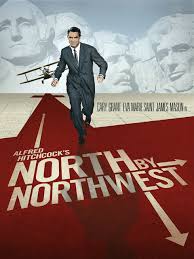
Roger Thornhill (Cary Grant) is an advertising executive in New York City. While at the Oak Room restaurant in the Plaza Hotel he realizes that he needs to send a telegram to his mother. He hails a page who is calling for a Mr. Kaplan. The page directs him to the appropriate service desk. Before he takes two steps he is surrounded by two men who believe he is Mr. Kaplan. They hustle him out of the Hotel lobby and take him to Long Island to the estate of Lester Townsend.
The two delivery boys, Valerian (Adam Williams) and Licht (Robert Ellenstein), put Thornhill in the library. Shortly after that Phillip Vandamm (James Mason) and his secretary Leonard (Martin Landau) enter the room and begin questioning Thornhill. Thornhill believes he is talking to Lester Townsend. Thornhill continues to deny he is Kaplan. Vandamm knows everything about Kaplan other than they have the wrong man. Not getting the answers they’re looking for Leonard and the minions pour liquor down him until he is roaring drunk. They prop him into a running car and proceed to run him off a cliff. Thornhill manages to survive the attempt but is arrested for drunk driving. He gets one phone call. He calls his mother. When the police check out his story about being kidnapped they find no evidence to support it.
Thornhill finds out that Kaplan is staying at the Plaza. He also finds out that Townsend is at the United Nations addressing the assembly. Checking out Kaplan’s hotel room he finds a picture of the man be believes is Townsend. He goes to the UN to confront him. He finds out that the man he thought was Townsend is actually someone else when he meets the real Townsend. As he is questioning Townsend Valerian throws a knife into the back of the real Townsend. Witnesses in the area believe Thornhill killed him. The police are now looking for him for murder.
While Thornhill is trying to find Kaplan to figure out what is happening a U.S. intelligent agency knows fully well that there really is no Kaplan and that somehow Thornhill was mistakenly identified as their fake agent. The agency’s plan was to establish the fake agent Kaplan to fool Vandamm into thinking Kaplan was hot on his trail. With Vandamm trying to find the fake Kaplan they would not be looking at their real agent who is a lot closer to Vandamm than he realizes.
Thornhill ends up following the non-existent Kaplan’s trail hoping it will lead him to Vandamm and some way of clearing himself. In doing so he ends up down a rabbit hole and in the middle of espionage, government secrets, double agents and a beautiful woman who just might be the death of him.
“North by Northwest” was released in 1959 and was directed by Alfred Hitchcock. It is a spy thriller with comedic undertones. It was selected in 1995 for preservation in the National Film Registry by the United States Library of Congress as being "culturally, historically, or aesthetically significant".
The idea for “North by Northwest” came from journalist Otis L. Guernsey, Jr. who suggested it to Sir Alfred Hitchcock. Guernsey got the idea of a nonexistent secret agent from a real life case from WWII known as Operation Mincemeat. British intelligence wanted to lure Italian and German forces away from a planned invasion site in Sicily. A cadaver was given a fake identity and papers that pointed to invasions of Sardinia and Greece. The actual event was used as a plot in the film “The Man Who Never Was” 1956.
According to Martin Landau it was his idea to play the character of Leonard as gay and in love with Phillip Vandamm. According to Landau Hitchcock and Screenwriter Ernest Lehman were very supportive of the idea. He said that: "Ernie Lehman added a line which was not in the Script.’Call it my woman's intuition' was not in the original script. It was a very daring line for the 1950s. Men didn't say things like that. Hitchcock loved what I did, and left me alone."
Leonard is not the only gay character that Hitchcock had in his films. Robert Walker’s character Bruno Anthony from “Strangers on a Train” 1951 and Brandon (John Dall) and Phillip (Farley Granger) from “Rope” 1948 were all gay characters. A few other films Hitchcock did also have gay characters as well. Unfortunately they were all villains. At the time Homosexuality was thought to have been a mental disorder. Naturally homosexuality was never explicit in Hitchcock’s films, especially since it was not allowed according to the Production Code but Hitchcock had a way of inserting subtle phrases and mannerisms that got around the code but still showed up in the characters.
Hitchcock himself had many gay friends and professional relationships with gay actors and screenwriters. Unfortunately using gay as a character flaw for some of his villains reinforced the negative homosexual stereotype which didn’t do his friends and favors even if he showed them as humans with human emotions.
The Hitchcock cameo appears during the opening credits. He is the man trying to get on a bus but the doors close in his face.
Jessie Royce Landis was only seven years older than Cary Grant, who plays her son.

